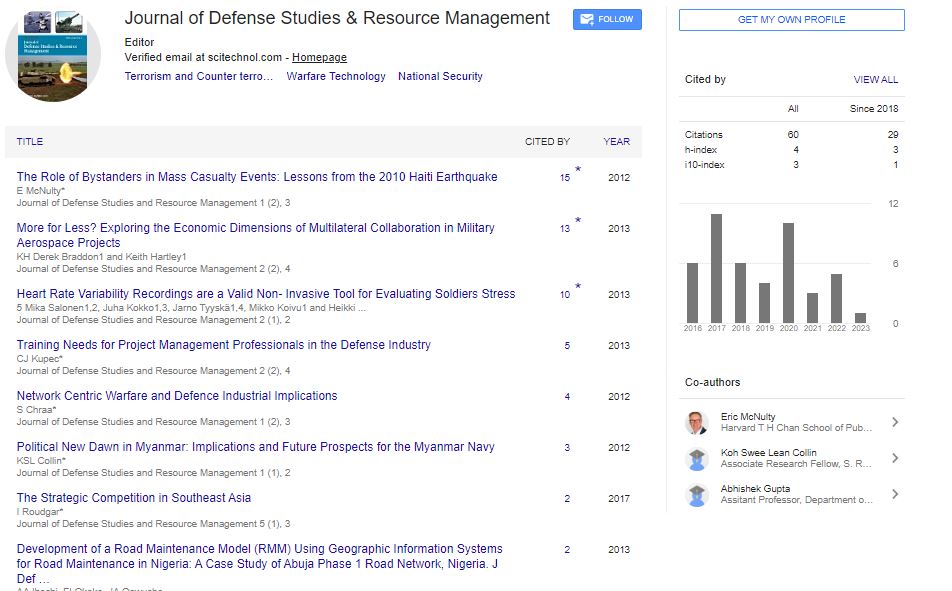Perspective, J Def Stud Resour Manage Vol: 11 Issue: 4
Insurgency and Inequality: An In-Depth Analysis of the Colombian Conflict
Harker Herrera*
1Economics Department, Universidad de los Andes, Bogotá, Cundinamarca, Colombia
*Corresponding Author: Harker Herrera,
Economics Department, Universidad de
los Andes, Bogotá, Cundinamarca, Colombia
E-mail: herrera36@uniandes.edu.co
Received date: 30 October, 2023, Manuscript No. JDSRM-23-120621;
Editor assigned date: 01 November, 2023, PreQC No. JDSRM-23-120621 (PQ);
Reviewed date: 16 November, 2023, QC No. JDSRM-23-120621;
Revised date: 23 November, 2023, Manuscript No. JDSRM-23-120621 (R);
Published date: 30 November, 2023, DOI: 10.4172/ 2324-9315. 1000189
Citation: Herrera H (2023) Insurgency and Inequality: An In-Depth Analysis of the Colombian Conflict. J Def Stud Resour Manage 11:4.
Abstract
The Colombian Conflict, a protracted and multifaceted struggle that spanned over half a century, stands as a testament to the complexities of internal conflicts. Waged primarily between the Colombian government and various insurgent groups, the conflict has left an indelible mark on the nation's history, society, and the lives of its citizens. This article explores the origins, key actors, and the path to peace in the Colombian Conflict.
Description
The Colombian Conflict, a protracted and multifaceted struggle that spanned over half a century, stands as a testament to the complexities of internal conflicts. Waged primarily between the Colombian government and various insurgent groups, the conflict has left an indelible mark on the nation's history, society, and the lives of its citizens. This article explores the origins, key actors, and the path to peace in the Colombian Conflict.
The roots of the Colombian Conflict can be traced back to the mid-20th century, with the emergence of various leftist guerrilla groups. The Revolutionary Armed Forces of Colombia (FARC), the National Liberation Army (ELN), and other paramilitary groups sought to address socio-economic disparities, political exclusion, and land distribution issues. The conflict was further fueled by the lucrative drug trade, as insurgent groups became involved in trafficking to fund their activities.
FARC (Revolutionary Armed Forces of Colombia): Formed in 1964, FARC became the largest and most formidable guerrilla group in Colombia. Initially rooted in Marxist-Leninist ideology, FARC evolved into a complex organization with involvement in drug trafficking and kidnapping for ransom.
ELN (National Liberation Army): Founded in 1964, ELN is another leftist guerrilla group that engaged in armed struggle against the government. ELN, influenced by liberation theology, aimed to establish a socialist state.
AUC (United Self-Defense Forces of Colombia): Emerging in the 1990s, AUC was a paramilitary group formed by landowners and drug traffickers to counter insurgent threats. Accused of human rights abuses, AUC played a significant role in the conflict.
Conflict, controversies, and hope
The Colombian government, facing challenges from insurgent groups, responded with military operations and, at times, human rights abuses. The government sought U.S. support through Plan Colombia, a bilateral initiative aimed at combating drug trafficking and insurgency. The Colombian Conflict witnessed periods of intense violence, with civilians often caught in the crossfire. Kidnappings, massacres, displacement, and human rights abuses became tragically commonplace. The conflict's impact on the civilian population prompted international concern and calls for a peaceful resolution.
In the mid-2000s, paramilitary groups, primarily AUC, began a demobilization process. However, concerns arose about the sincerity of this process, as some members continued illegal activities. The Colombian government engaged in peace talks with FARC and ELN at various points, with mixed success. The peace negotiations faced challenges related to trust, demands for justice, and the complexities of integrating former combatants into society.
The pursuit of peace in Colombia included efforts to address the rights of victims and establish mechanisms for transitional justice. The Special Jurisdiction for Peace (JEP) was created to investigate and prosecute those responsible for serious crimes during the conflict. A significant breakthrough occurred in 2016 when the Colombian government and FARC reached a historic peace agreement. The accord addressed key issues such as land reform, political participation, drug trafficking, and transitional justice.
While the peace accord marked a crucial step, its implementation faced challenges. There were concerns about the reintegration of former FARC combatants, opposition from political factions, and ongoing violence in certain regions. The journey toward lasting peace in Colombia remains ongoing. Challenges persist, including the presence of other armed groups, social inequality, and the impact of drug trafficking. However, the peace process has provided a glimmer of hope, fostering dialogue and reconciliation.
Conclusion
The Colombian Conflict, with its roots in historical grievances and complex socio-political dynamics, has tested the resilience of the nation. The path to peace, marked by negotiations, demobilizations, and transitional justice mechanisms, represents a courageous effort to break the cycle of violence. As Colombia continues to grapple with the aftermath of the conflict, the commitment to reconciliation, justice, and inclusive development stands as a beacon of hope for a more peaceful and stable future. The Colombian people, with their strength and resilience, navigate the complex journey from conflict to coexistence, laying the groundwork for a nation that transcends the shadows of its turbulent past.
 Spanish
Spanish  Chinese
Chinese  Russian
Russian  German
German  French
French  Japanese
Japanese  Portuguese
Portuguese  Hindi
Hindi 